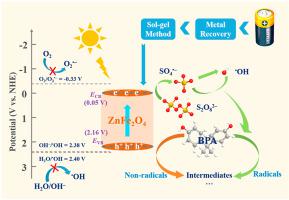Journal of Cleaner Production ( IF 11.1 ) Pub Date : 2020-09-18 , DOI: 10.1016/j.jclepro.2020.124246 Ruimeng Li , Hanwen Hu , Yanyan Ma , Xingyu Liu , Litong Zhang , Sirui Zhou , Boyu Deng , Heng Lin , Hui Zhang

|
Zinc ferrite (ZnFe2O4) with visible (Vis) light response was synthesized via sol-gel method by using waste alkaline Zn-Mn batteries as raw materials. The morphology, composition and optical properties of ZnFe2O4 were characterized. In order to suppress the fast recombination of photoinduced electron-hole pairs and improve the photocatalytic performance of ZnFe2O4, peroxydisulfate (PDS) was introduced to the photocatalytic system as the external electron acceptor. With the presence of PDS, the removal efficiency of target contaminant bisphenol A (BPA) achieved 96.5% in a 120 min reaction at natural pH 6.0. Photoluminescence (PL) spectroscopy combined with amperometric tests was used to determine the role of PDS on the performance of photocatalytic reaction. The main reactive species for BPA removal were determined by electron paramagnetic resonance (EPR) measurement and quenching experiments. The results indicated that the holes and reactive species (SO4•– and •OH) produced by activation of PDS with photogenerated electrons mainly contributed to the elimination of BPA. Furthermore, the effect of various operating parameters on the removal of BPA as well as the reusability and stability of catalyst was investigated to explore the applicability of ZnFe2O4 used in the PDS-mediated photocatalytic system for wastewater treatment.
中文翻译:

在可见光下过硫酸盐增强的双酚A在废电池衍生的ZnFe 2 O 4上的光催化降解
以废碱性锌锰电池为原料,通过溶胶凝胶法合成了可见光(Vis)光响应的铁酸锌(ZnFe 2 O 4)。表征了ZnFe 2 O 4的形貌,组成和光学性质。为了抑制光致电子-空穴对的快速复合并提高ZnFe 2 O 4的光催化性能,过氧二硫酸盐(PDS)作为外部电子受体被引入到光催化体系中。在存在PDS的情况下,在自然pH 6.0下的120分钟反应中,目标污染物双酚A(BPA)的去除效率达到96.5%。使用光致发光(PL)光谱结合安培测试来确定PDS对光催化反应性能的作用。通过电子顺磁共振(EPR)测量和淬灭实验确定了去除BPA的主要反应物种。结果表明,空穴和反应性物种(SO 4 •–和•由光生电子活化PDS产生的OH)主要有助于消除BPA。此外,研究了各种操作参数对去除BPA以及催化剂的可重复使用性和稳定性的影响,以探索ZnFe 2 O 4在PDS介导的光催化系统中用于废水处理的适用性。


























 京公网安备 11010802027423号
京公网安备 11010802027423号